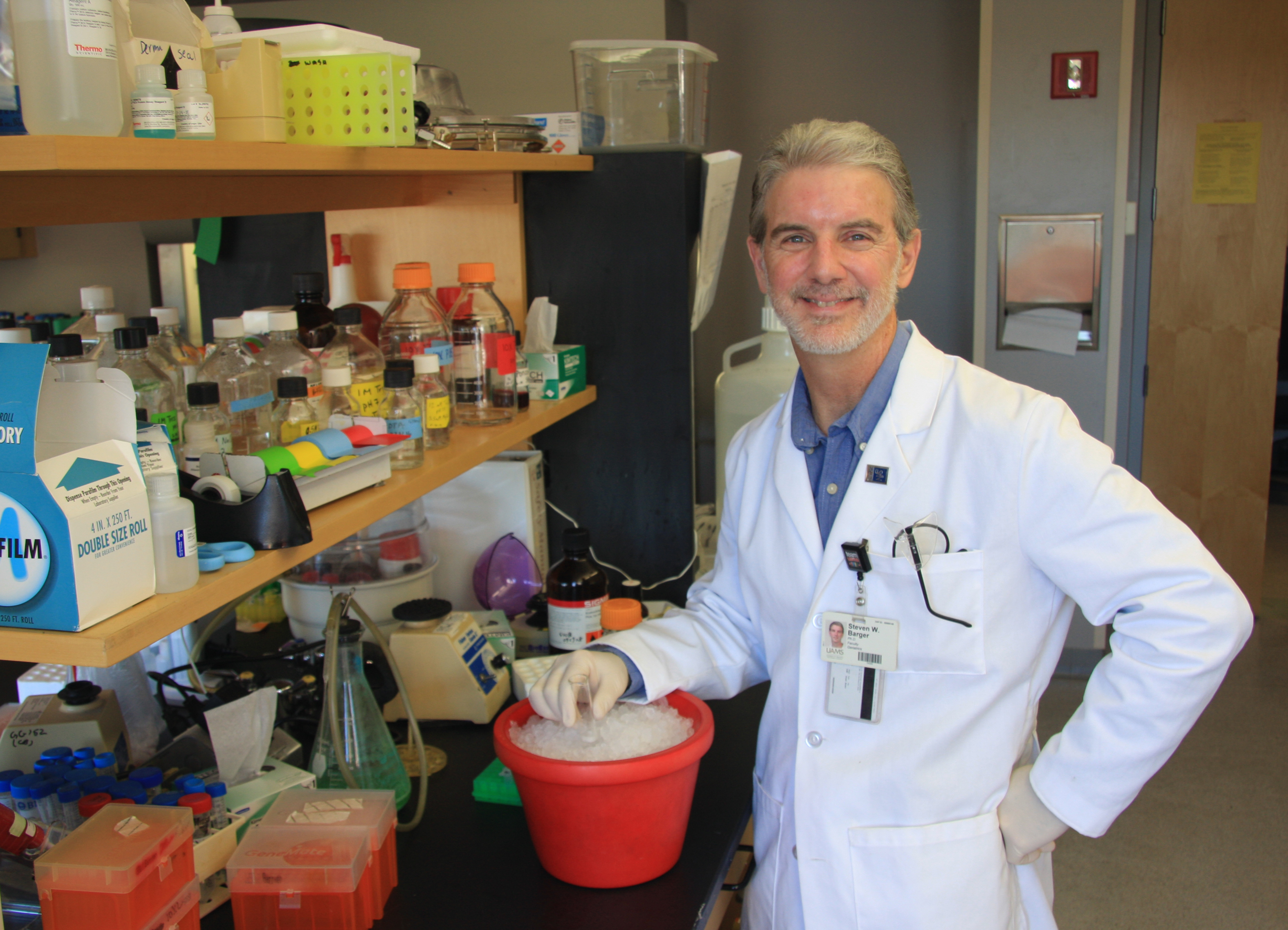UAMS Scientist Shows Brain Sugar Malfunction in Alzheimer’s, Gains National Attention
| Steven Barger, Ph.D. — a researcher at the University of Arkansas for Medical Sciences (UAMS) — has entered the national spotlight for showing how the mechanism that brings sugar to the brain malfunctions in people with Alzheimer’s disease, highlighting a potential target for treatment.
The study also explains why Alzheimer’s can mimic the symptoms of diabetes, and ultimately concludes there is not as strong a connection between the two diseases as previously believed. The work also deepens the understanding of how the brain uses sugar, or glucose, to fuel important mental functions and memory.
Barger is a professor with appointments in the Geriatrics, Neurobiology and Developmental Sciences, and Internal Medicine departments in the UAMS College of Medicine. His work was featured during a news conference hosted by the Society for Neuroscience at its annual meeting in Chicago. The findings were featured in Forbes, the American Association for the Advancement of Science EurekAlert!, and other outlets such as dLife.
Researchers have long tried to explain the apparent connection between Type 2 diabetes and Alzheimer’s disease. A diabetes diagnosis doubles a person’s risk of developing dementia. Memory loss and other symptoms of dementia are common among older adults with diabetes. However, Alzheimer’s is just one form of dementia, and it includes other unique symptoms that diabetes does not. Notably, brain samples of diabetics do not show excessive beta-amyloid peptide, which is a hallmark of Alzheimer’s.
These observations have led scientists to question whether diabetes leads to Alzheimer’s or if the converse might be true. Barger’s research began as an exploration of whether Alzheimer’s might cause some cases of diabetes.
Barger looked at Alzheimer’s brains and discovered a very specific process at work. He focused on a protein called glucose transporter 1 (GLUT1), which takes glucose from the blood vessels to the neurons in the brain, and found that beta-amyloid peptide can cause GLUT1 to be defective. The result is that the brain does not get enough glucose, and excess glucose backs up in the blood, mimicking diabetes.
“Our model indicated that, rather than diabetes, people with Alzheimer’s may have higher glucose in their blood simply because they are not transporting as much into the brain, and this may be responsible for the problems with the high blood sugar levels common to Alzheimer’s,” Barger said.
Glucose, here represented by hexagons, is delivered to the brain via blood vessels. It is shuttled from the blood into astrocytes (brown), a type of brain cell that relays the glucose to neurons (green). This is especially important at synapses, the site at the ends of long extensions where neurons communicate with one another (lightning bolts). When the rate of their firing increases — during the creation of a memory, for instance — neurons receive glucose at higher rates from the astrocyte conduit. Zooming in to the junction between the blood vessel and the astrocyte’s extension, we see that the glucose is shuttled between two versions of GLUT1: GLUT1-B in the blood vessel wall and GLUT1-A in the astrocyte membrane. In Alzheimer’s disease, the astrocytes installation of GLUT1-A in their membranes falters. Less glucose is available to the synapses for making memories, and more is left in the blood, moderately elevating blood sugar levels.
Barger suggests further research could focus on finding ways to ensure the brain continues to get glucose by targeting GLUT1.
“Multiple therapies that reduce brain levels of beta-amyloid have failed in Alzheimer’s treatment trials in recent years, perhaps because it is nearly impossible to remove the beta-amyloid fast enough, before it has kicked off its deadly chain reaction that causes the debilitating symptoms of Alzheimer’s,” Barger said. “Interfering with later events, further down the chain, may be the best hope for preventing dementia. If impaired glucose delivery is a key element of this chain reaction, it may be fruitful to reinforce the sugar bucket brigade.”
Barger’s work coincided with emerging studies by other scientists who have looked at diabetes brain samples and found that the cognitive symptoms of diabetes are related to what is called “vascular dementia,” which results from damage to blood vessels. High blood pressure and arterial plaque are common complications of Type 2 diabetes.
“The two diseases appear to be quite distinct,” Barger said.
Barger’s abstract was one of about 50 to be highlighted at the Society for Neuroscience news conference out of more than 14,000 submitted.
The project included UAMS colleagues Antiño Allen, Ph.D., in the College of Pharmacy; Gwen Childs, Ph.D., and Angela Odle, Ph.D., in Neurobiology and Developmental Sciences; Yang Ou, Ph.D., a research associate in Geriatrics; graduate student Jakeira Davis; and former graduate student Rachel Hendrix, Ph.D.
UAMS is the state’s only health sciences university, with colleges of Medicine, Nursing, Pharmacy, Health Professions and Public Health; a graduate school; a hospital; a main campus in Little Rock; a Northwest Arkansas regional campus in Fayetteville; a statewide network of regional campuses; and eight institutes: the Winthrop P. Rockefeller Cancer Institute, Jackson T. Stephens Spine & Neurosciences Institute, Harvey & Bernice Jones Eye Institute, Psychiatric Research Institute, Donald W. Reynolds Institute on Aging, Translational Research Institute, Institute for Digital Health & Innovation and the Institute for Community Health Innovation. UAMS includes UAMS Health, a statewide health system that encompasses all of UAMS’ clinical enterprise. UAMS is the only adult Level 1 trauma center in the state. UAMS has 3,485 students, 915 medical residents and fellows, and seven dental residents. It is the state’s largest public employer with more than 11,000 employees, including 1,200 physicians who provide care to patients at UAMS, its regional campuses, Arkansas Children’s, the VA Medical Center and Baptist Health. Visit www.uams.edu or uamshealth.com. Find us on Facebook, X (formerly Twitter), YouTube or Instagram.###
